Chapter 2
Payoff and Profit Diagrams
In an earlier chapter, we had discussed intrinsic value and time value. Intrinsic value is based on the relation of the underlying stock or index price with the strike price. For call options, if the underlying price is above the strike price, then the call option has intrinsic value. For put options, if the underlying price is below the strike price, then the put option has intrinsic value.
In terms of time value, the option will have a time value up until the market closes on its expiration date. Once an option has expired and time value has dropped to zero, it will either have intrinsic value or be worthless.
Since intrinsic value is based on underlying price and strike price, we can create a visualisation of all possible financial outcomes. These are commonly known as payoff diagrams.
Plotting payoff for Call options
In the table below, we list an increasing hypothetical underlying price. We also list a strike price. As discussed previously, the intrinsic value of a call option is the underlying price minus the strike price.
However, the intrinsic value for a purchased call option cannot be less than zero. This goes back to the definition of a call option: the right but not the obligation to purchase the underlying at a specific price. Since we don’t have the obligation to purchase the underlying at the strike price, we would never do that if the strike price is more than the underlying. Therefore, the intrinsic value for the call option where the underlying price is equal to or less than the strike price will be zero. This is shown in illustration 1 below.
Illustration 1
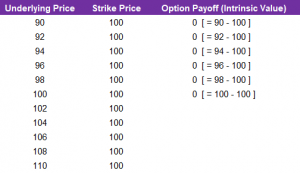
In illustration 2, we expand our table to include situations where the underlying price is above the strike price.
Illustration 2
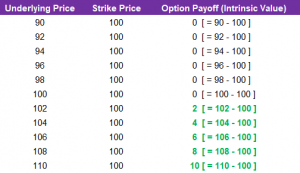
Since the option payoff, or intrinsic value, of a purchased call option cannot go below zero, the payoff formula is a conditional formula. Specifically, the formula for a purchased call option is:
Call Option Payoff (intrinsic value) = Max (Underlying Price – Strike Price, 0)
This formula means that you take the maximum of the difference between the underlying price and strike price or 0.
Now that we have a list of the intrinsic values that are associated with a level of the underlying price, we can plot them as a chart. Below is the payoff diagram of a purchased, or long, call option.
Illustration 3
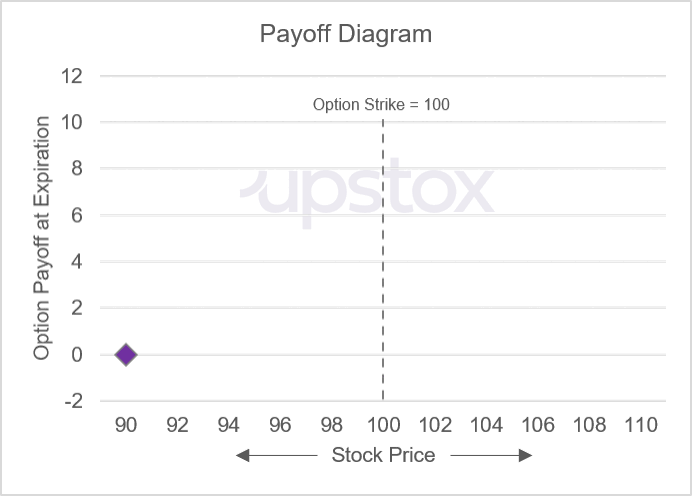
Plotting payoff for Put options
For put options, we need to use a slightly modified formula to determine the intrinsic value at various underlying prices. To calculate the put option payoff, we subtract the underlying price from the strike price.
As seen below in illustration 4, when the underlying price is higher than the strike price, the intrinsic value is zero. As a reminder, put options give us the right, but not the obligation, to sell the underlying at a specified price. If we could sell an index or stock at a higher price than the strike price, we would instead just sell on the open market rather than sell at the lower strike price.
As a result, the payoff formula for the intrinsic value of a purchased put option is:
Put Option Payoff (intrinsic value) = Max (Strike Price – Underlying Price, 0)
This formula means that you take the maximum difference between strike price and underlying price or zero.
Illustration 4

As we plot the underlying price with the calculated payoff, we get the following payoff diagram that is shown in illustration 5 below.
Illustration 5
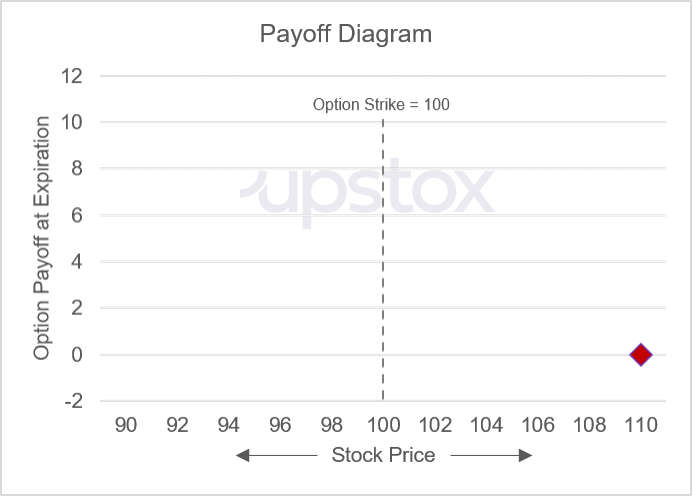
Profit Diagram
One last concept we will introduce in this chapter is the profit diagram. The payoff diagrams that we’ve shown only account for the intrinsic value of the option or the relationship between underlying price at expiration and the strike price. What we haven’t discussed is the cost to purchase this option. Once we account for this cost, the payoff diagram can be seen as a profit diagram.
Going back to the call option example, the option payoff is zero whenever the underlying price of 100 equals the strike price of 100. In illustration 6 below, we add additional columns for the option cost and the option profit. We are assuming that this call option cost us 1 to purchase. When the option payoff is less than the cost to purchase the option, then the profit of the trade will be negative. For example, if the underlying price at expiration is 98, then the payoff of the call option will be 0. Since it costs 1 to buy the option, your profit is -1. As seen in the table below, the most you can lose is 1 which is the cost to buy the option.
Illustration 6

In the table, we highlight the row where the underlying price at expiration is 101. This is the break-even price or break-even point.
It is the break-even point because when you subtract the cost to buy the option from the option’s payoff, you get a profit of 0. For a call option, if the underlying price is higher than 101 at expiration, then you will end up with a profit from this option’s trade.
In the chart below, we highlight the subtle difference between the payoff diagram for the call option and incorporating the option’s cost to get to the profit diagram. When you plot the profit diagram, you can also easily visualise the break-even price.
Illustration 7
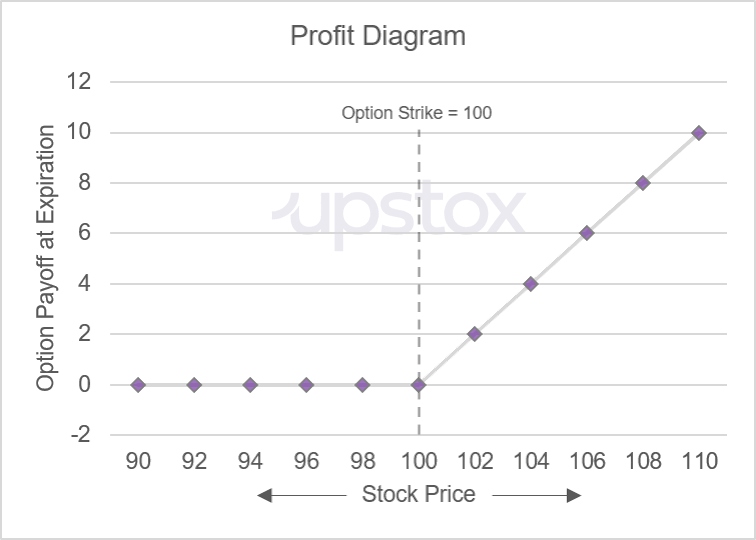
One last consideration is that we are only discussing the costs associated with purchasing an option to calculate profit. Brokerages charge commissions as well as mandatory exchange fees for each transaction. Traders need to also consider these as part of their individual profit calculation.
To Conclude:
- Use a Payoff diagram to visualise all possible financial outcomes of a strategy.
- For call options, plot payoff diagram using strike price, an increasing underlying price and the corresponding intrinsic value.
- For put options, plot payoff diagram using strike price, a decreasing underlying price and the corresponding intrinsic value.
- Include cost to purchase the option in the payoff diagram to plot a profit diagram.
- A profit diagram helps you visualise the break-even price, or the point at which the trade turns profitable.
Key Formulae
- Payoff for Call options (intrinsic value) = Max (Underlying Price – Strike Price, 0)
- Payoff for Put options (intrinsic value) = Max (Strike Price – Underlying Price, 0)
Why chart a payoff or profit diagram?
It’s simple - chart a payoff diagram to visualise how your strategy could potentially pan out. Draw a profit chart to estimate risk or reward in executing the trade. After all, as the quote goes - The man who is prepared has half his battle fought. Stay with us. We will tackle Options Pricing in the next chapter.

Test your OQ (Options Quotient)
Take your first step towards financial independence with the right training.



